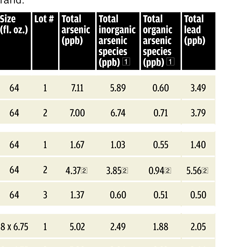Consumer Reports Study Finds High Levels Of Arsenic & Lead In Some Fruit Juice
While federal standards set limits for the amount of arsenic and lead in tap and bottled water, but no such hard line exists for fruit juices, even though such drinks are dietary staples of children. Thus, our cousins-in-arms at Consumer Reports set to testing some juices, only to turn up results that should cause concern among parents and lawmakers.
The folks at CR tested 88 samples of apple juice and grape juice and found that 10% of the samples had total arsenic levels that exceeded federal drinking-water standards of 10 parts per billion (ppb) and 25% of the samples had lead levels higher than the Food and Drug Administration’s bottled-water limit of 5 ppb.
The study also differentiates between organic arsenic and inorganic, which is thought to be the more harmful of the two types. Unfortunately, in almost all cases the inorganic arsenic outnumbered the arsenic.
Here are some points of interest from the study:
• In apple juice, arsenic levels ranged from 1.1 to 13.9 ppb; grape-juice levels were even higher, 5.9 to 24.7 ppb.
• In Consumer Reports’ tests, the following brands had at least one sample of apple juice that exceeded 10 ppb of total arsenic: Apple & Eve, Great Value (Walmart), and Mott’s. For grape juice, at least one sample from both Walgreens and Welch’s exceeded that threshold.
• About one-fourth of all juice samples had levels at or above the 5 ppb federal limit for lead in bottled water. The top lead level for apple juice was 13.6 ppb and 15.9 ppb for grape juice.
• Some brands had one or more samples of apple juice that exceeded 5 ppb for lead: America’s Choice (A&P), Gerber, Gold Emblem (CVS), Great Value, Joe’s Kids (Trader Joe’s), Minute Maid, Seneca, and Walgreens. Grape juice from Gold Emblem, Walgreens, and Welch’s each had at least one sample that contained lead levels in excess of 5 ppb.
The full chart of results, which also lists the countries of origin for the juices, can be found below and at www.ConsumerReports.org/juicebox.
To check things on the other end of the digestive system, Consumer Reports also analyzed the Centers for Disease Control and Prevention’s National Health and Nutrition Examination Survey data on total urinary arsenic of participants who reported their food and drink consumption for 24 hours the day before being tested.
To ensure the most accurate analysis, Consumer Reports excluded people who regularly ate seafood, since seafood is a major source of a form of arsenic that is generally considered to be nontoxic.
The result: People who reported drinking apple or grape juice had, on average, about 20% higher levels of total urinary arsenic than those subjects who did not.
So between its own study and the analysis of the CDC data, Consumers Union, the advocacy arm of Consumer Reports, believes the federal government should establish a standard of 3 ppb for total arsenic and 5 ppb for lead in juice.
If those limits were put into place, that would mean that 41% of the juices in the study would have met or exceeded the thresholds for both lead and arsenic.
“Our test findings of arsenic and lead in apple juice are in line with existing data from the Food and Drug Administration,” said Urvashi Rangan, Ph.D., Director of Safety & Sustainability at Consumer Reports. “In fact, the agency has found higher levels of arsenic and lead in apple juice. We’re concerned about the potential risks of exposure to these toxins especially for children who are particularly vulnerable because of their small body size and the amount of juice they regularly consume.”
To that end, just last week the FDA that it is seriously considering setting guidance for permissible levels of inorganic arsenic in apple juice and that it is gathering data to determine what an appropriate level would be.
In the announcement, the FDA revealed the results of its own previously undisclosed test results of eight apple juice samples analyzed around 2008 through 2011 that showed levels of total arsenic of up to 45 ppb.
In addition to setting the levels mentioned above, Consumers Union is suggesting the federal government do the following:
• Eliminate use of arsenicals in animal feed.
• Ban all uses of organic arsenical pesticides.
• Prohibit use of arsenic-laden fertilizers in agriculture.
• The Environmental Protection Agency (EPA) should lower the 10 ppb drinking-water limit for arsenic.
“Our proposed limit of 3 ppb total arsenic accepts a lenient risk tolerance of one excess cancer for every 1,000 people. Safety limits based on a risk tolerance of one in a million people to no more than one in 10,000 are considered to be ideally protective of cancer risk. Three ppb total arsenic is a reasonable and practical limit that appears to be achievable at this time based on our findings,” said Dr. Rangan.
If you would like to support Consumers Union’s to do more food testing and safety analysis, go to BuySafeEatWell.org for more information and to donate.
Want more consumer news? Visit our parent organization, Consumer Reports, for the latest on scams, recalls, and other consumer issues.



